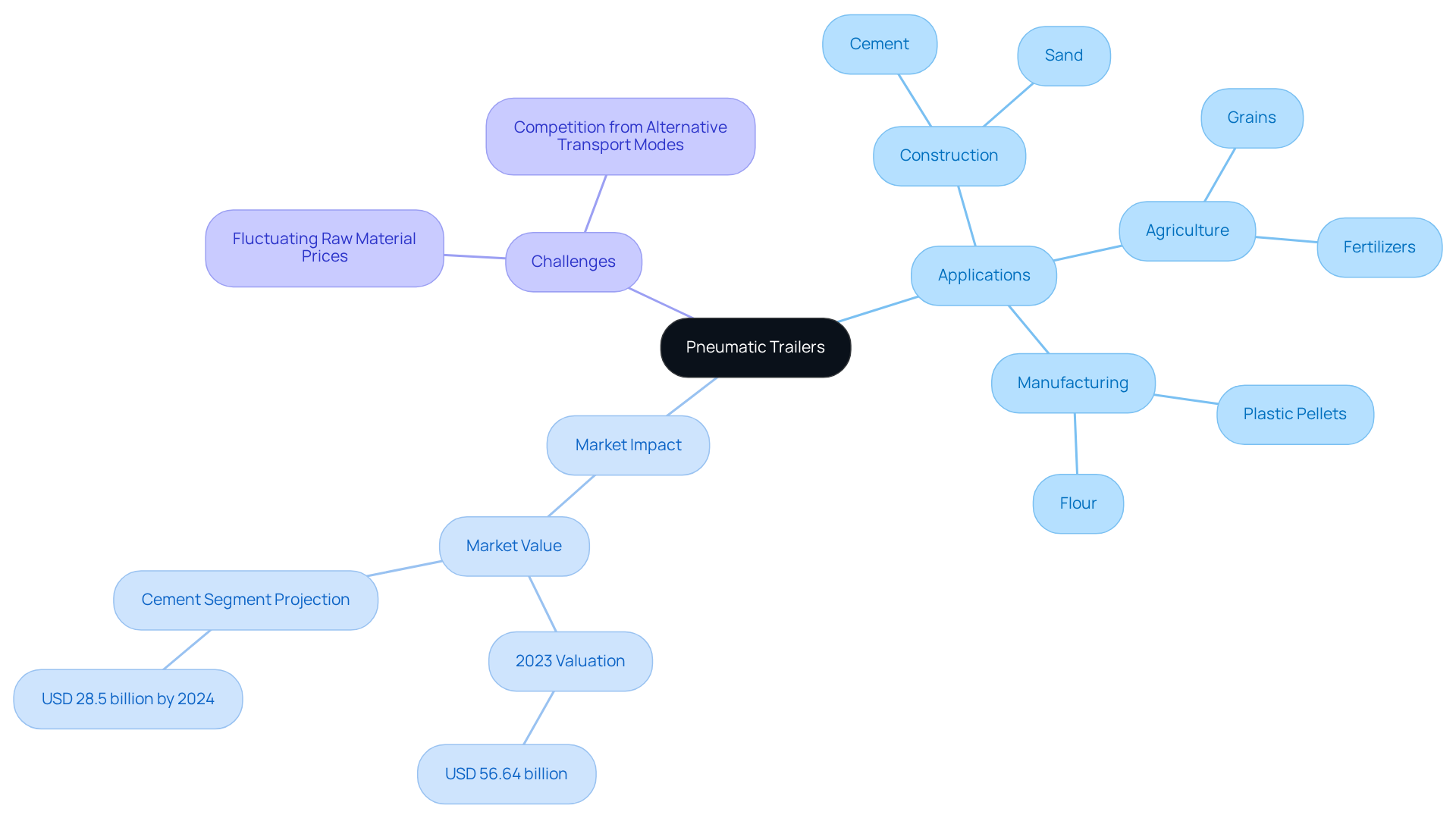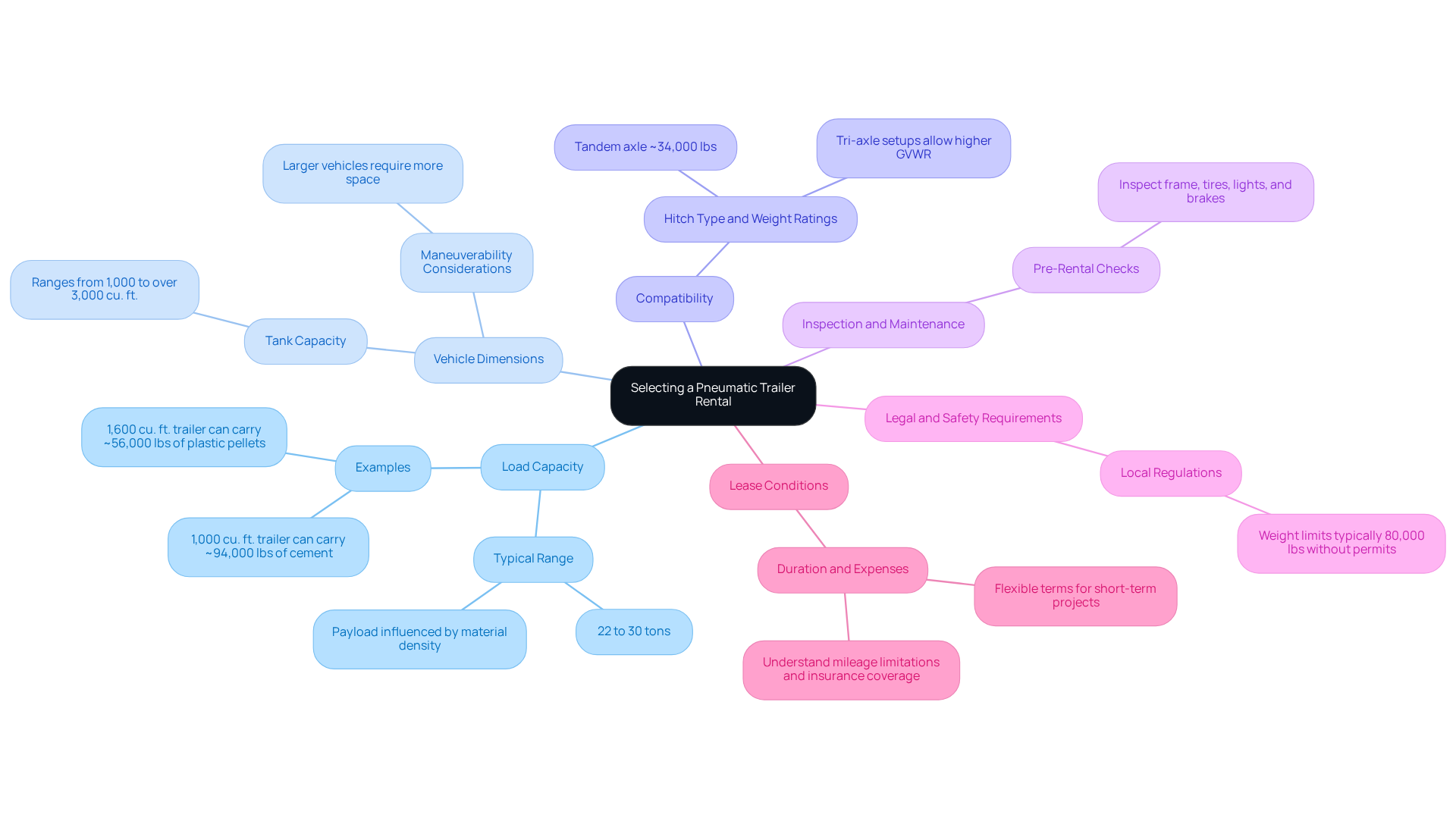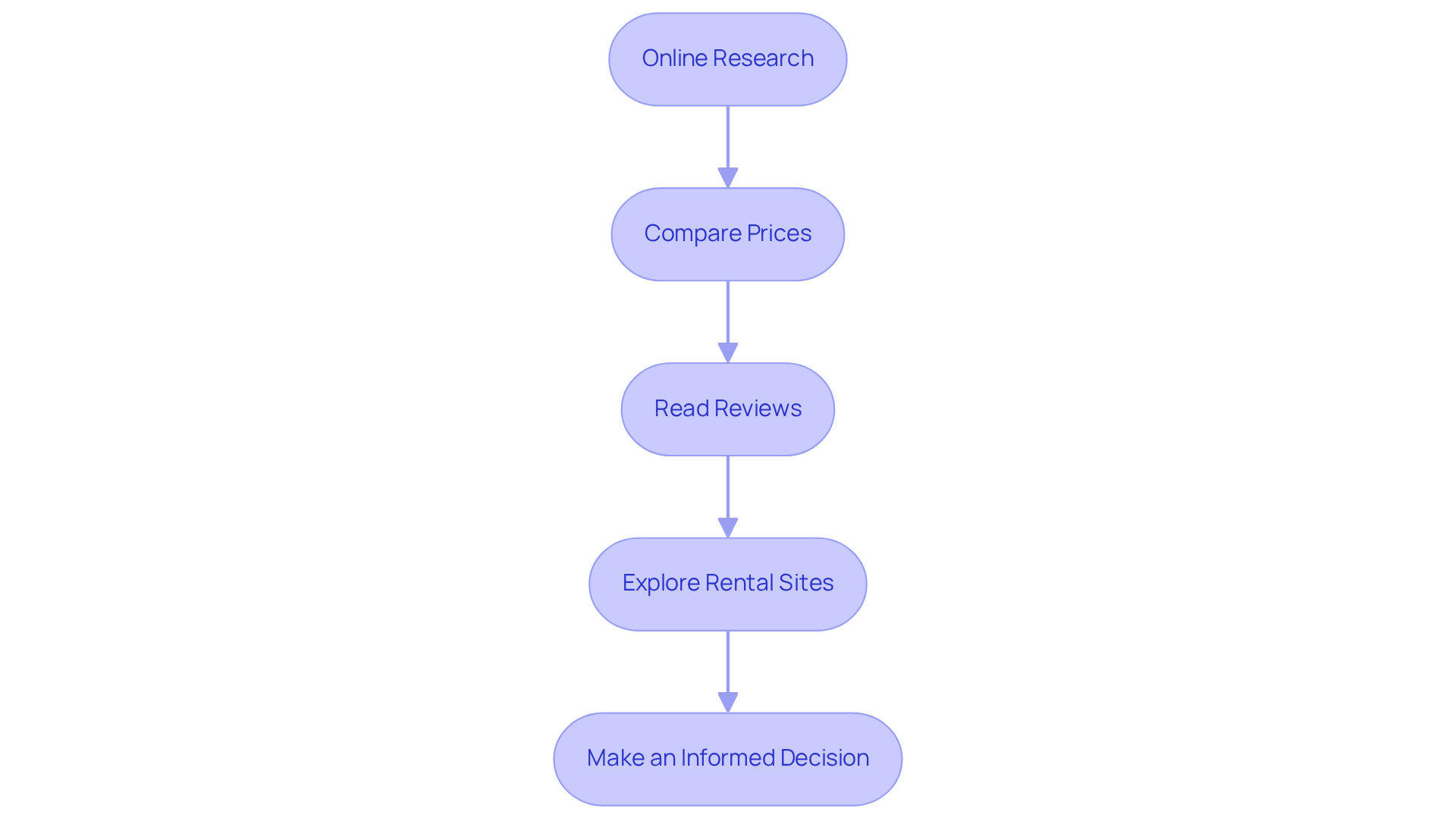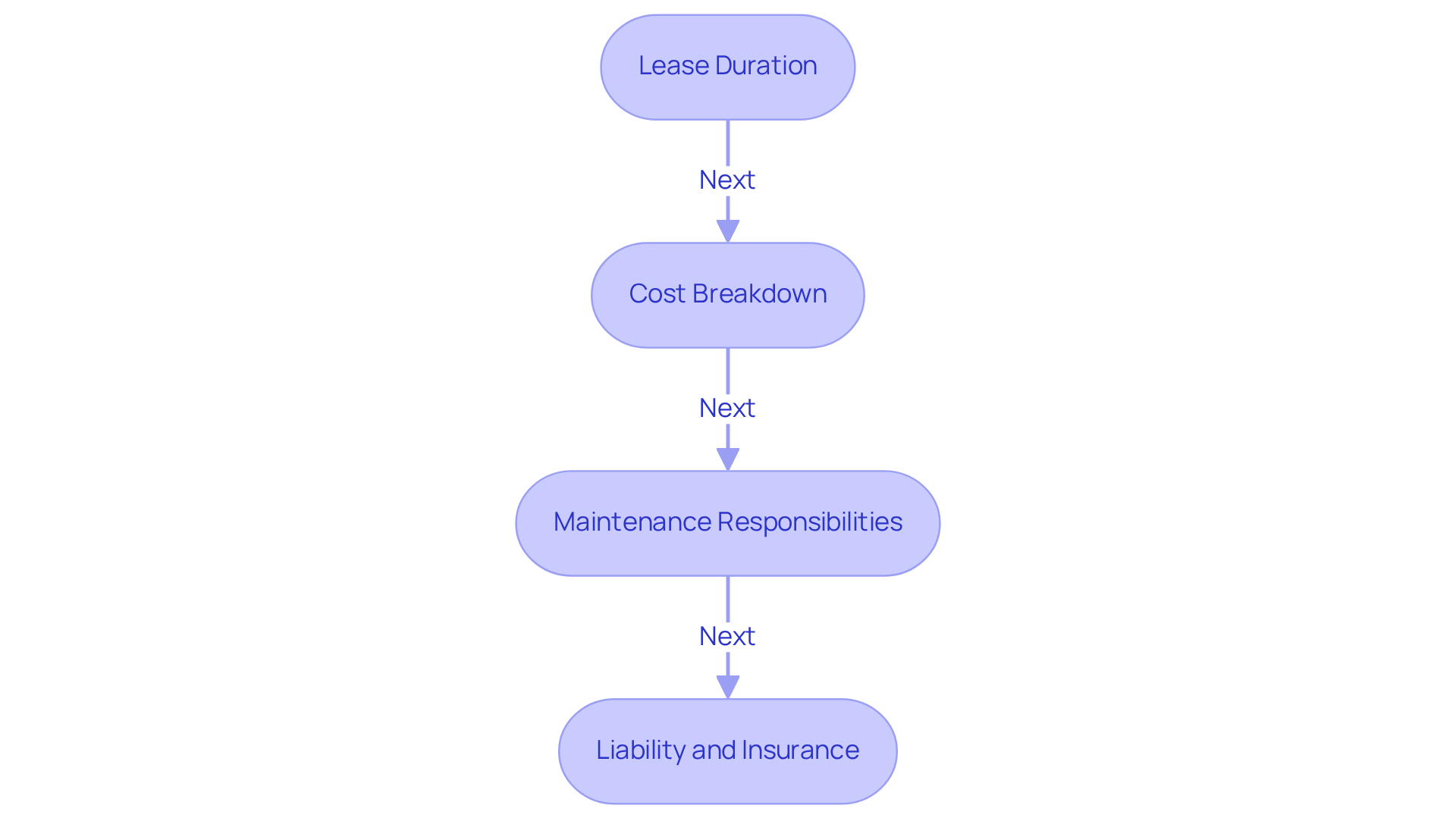Overview
Selecting the right pneumatic trailer rental is crucial for project success. To ensure you make an informed choice, follow these four essential steps:
- Evaluate load capacity
- Assess vehicle dimensions
- Verify compatibility with your towing apparatus
- Thoroughly review rental agreements
Each of these steps plays a vital role in aligning the trailer's specifications with your project needs. Furthermore, understanding the terms of the lease is imperative to avoid unexpected costs and ensure compliance with legal requirements. By adhering to these guidelines, you can confidently navigate the rental process and secure the right equipment for your needs.
Key Highlights:
- Pneumatic trailers are designed for transporting dry bulk substances like cement, sand, and flour using compressed air for efficient loading and unloading.
- Key applications include construction (transporting cement and sand), agriculture (managing grains and fertilisers), and manufacturing.
- Recent advancements in technology enhance the efficiency and sustainability of pneumatic transport vehicles.
- The global bulk transport vehicle market was valued at approximately USD 56.64 billion in 2023, with significant contributions from the cement sector projected to reach USD 28.5 billion by 2024.
- When selecting a pneumatic trailer rental, consider load capacity, vehicle dimensions, compatibility with towing apparatus, inspection and maintenance requirements, legal and safety regulations, and lease conditions.
- Conduct thorough online research, compare prices, read customer reviews, and inspect vehicles in person to find suitable rental options.
- Review rental agreements carefully, focusing on lease duration, cost breakdown, maintenance responsibilities, and liability and insurance terms to avoid potential disputes.
Introduction
Pneumatic trailers, engineered for the efficient transport of dry bulk materials, serve a critical function in sectors such as construction and agriculture. With the increasing demand for these specialized vehicles, it becomes imperative to understand the nuances of selecting the right pneumatic trailer rental to guarantee project success.
Key factors must be considered to navigate the complexities of rental agreements and options effectively:
- Understand the specific requirements of your project.
- Research different rental companies and their offerings.
- Compare rental costs and terms.
- Review the maintenance and condition of the trailers.
Additionally, awareness of common pitfalls in this process can significantly enhance the rental experience.
Understand Pneumatic Trailers and Their Applications
Pneumatic units, often referred to as dry bulk tank vehicles, are specialized conveyances expertly designed for the efficient transportation of dry bulk substances such as cement, sand, flour, and plastic pellets. By utilizing compressed air, these vehicles enable rapid loading and unloading processes, making them indispensable across various sectors. Their primary applications span construction, agriculture, and manufacturing, where swift and secure transportation of bulk materials is crucial.
In the construction industry, pneumatic vehicles play a vital role in transporting materials like cement and sand, ensuring minimal spillage and contamination. The agricultural sector also benefits significantly, as these vehicles are employed to manage grains and fertilizers, thereby enhancing distribution efficiency. Recent advancements in transport technology, including lightweight designs and automated loading systems, are further improving operational efficiency and sustainability within these industries.
As the market for air-operated transport vehicles continues to grow, forecasts indicate a substantial share in both construction and agriculture by 2025. Understanding their capabilities and applications is essential for making informed decisions about pneumatic trailer rental. Industry experts emphasize the importance of selecting the appropriate air-powered transport vehicle to meet specific project requirements, ensuring optimal performance and cost efficiency. Furthermore, the global bulk transport vehicle market was valued at approximately USD 56.64 billion in 2023, underscoring its economic significance. The cement segment alone is projected to generate around USD 28.5 billion by 2024, illustrating the impact of air-powered vehicles in the construction sector. However, challenges such as fluctuating raw material prices and competition from alternative transport modes persist, necessitating careful consideration during the selection process.

Identify Key Factors for Selecting a Pneumatic Trailer Rental
When choosing a pneumatic trailer rental, it is essential to consider several key factors to ensure optimal performance and compliance.
-
Load Capacity: Evaluate the weight and volume of the items to be transported. Pneumatic vehicles generally possess a payload capacity varying from 22 to 30 tons, influenced by the density of the substances. For example, a 1,000 cubic foot container can carry approximately 94,000 pounds of cement; however, it can also transport between 18 to 20 tons depending on material density. This underscores the importance of aligning the vehicle's capacity with your cargo requirements.
-
Vehicle Dimensions: Select a vehicle size that meets your transportation needs. Pneumatic units are classified by tank capacity, typically measured in cubic feet, and generally range from 1,000 to more than 3,000 cubic feet. While larger vehicles can accommodate bigger loads, they also require more space for maneuvering, which is crucial on construction sites.
-
Compatibility: Ensure the vehicle is suitable for your towing apparatus. This includes checking the hitch type and weight ratings. For instance, a tandem axle vehicle usually accommodates approximately 34,000 pounds combined, while tri-axle setups can permit greater gross vehicle weight ratings. Therefore, compatibility assessments are essential for secure transport.
-
Inspection and Maintenance: Before use, examine the vehicle for wear and damage, including the frame, tires, lights, and brakes. This step is critical for ensuring safety and compliance during transport.
-
Legal and Safety Requirements: Be aware of local legal and safety requirements regarding trailer size and weight limits. Understanding these regulations is crucial for compliance and avoiding fines.
-
Lease Conditions: Examine the lease duration and related expenses. Numerous leasing firms, such as EZ Equipment Rental, provide flexible conditions that can be beneficial for short-term projects. Grasping the details of the leasing agreement, including mileage limitations and insurance coverage, can assist in preventing unforeseen charges.
By thoroughly assessing these aspects, you can choose a pneumatic trailer rental that aligns with your project requirements while ensuring adherence to legal weight restrictions and safety rules.

Research and Compare Pneumatic Trailer Rental Options
To identify the most suitable pneumatic trailer rental options, follow these essential steps:
- Engage in Online Research. Utilize online platforms to explore local leasing companies that specialize in pneumatic trailer rental vehicles. These websites provide comprehensive listings that will help you pinpoint potential providers.
- Compare Prices. Collect estimates from various leasing firms. While price is a critical factor, it is equally important to assess the quality of service and the condition of the trailers. This holistic approach ensures you select a provider that aligns with both your budgetary and operational needs.
- Take the time to Read Reviews. Investigate customer feedback and testimonials to gauge the trustworthiness of leasing firms. Positive feedback often reflects a provider's commitment to quality and customer satisfaction, which is vital for a successful leasing experience.
- If feasible, Explore Rental Sites. Visit locations to inspect the vehicles in person. This hands-on evaluation allows you to assess their condition and suitability for your specific requirements, ensuring that you make an informed decision.
By adhering to these steps, you can effectively navigate the pneumatic trailer rental market, ensuring you secure the finest options for your projects.

Review Rental Agreements and Understand Terms
Before concluding your pneumatic trailer rental, it is essential to conduct a thorough examination of the agreement. Focus on the following key aspects:
-
Lease Duration: Confirm the start and end dates of the lease period. Be mindful that late returns can incur additional charges, often calculated at the daily usage rate, which can significantly escalate overall costs. For example, if the daily rate is $100 and you return the vehicle two days late, you could face an extra $200 in fees.
-
Cost Breakdown: Ensure that all costs are transparently outlined in the agreement. This includes potential additional fees for mileage, insurance, or damage, which can accumulate quickly if not clearly defined. For instance, a leasing contract might specify a base rate of $500 for the vehicle, with additional mileage charges of $0.50 per mile beyond a designated limit.
-
Maintenance Responsibilities: Clarify who is accountable for maintenance and repairs during the leasing period. Understanding the procedures for reporting issues is crucial to avoid disputes later on. For air-operated vehicles, it is frequently the lessee's duty to perform routine inspections and promptly inform of any issues.
-
Liability and Insurance: Carefully review the liability clauses to understand your responsibilities in the event of damage or accidents. It may be prudent to consider purchasing additional insurance to cover unforeseen incidents. According to legal experts, understanding these terms can prevent costly disputes and ensure you are adequately protected.
By paying close attention to these elements, you can ensure a smoother pneumatic trailer rental experience and mitigate potential risks associated with it.

Conclusion
Selecting the right pneumatic trailer rental is paramount for ensuring efficiency and compliance in transporting bulk materials. By grasping the specific applications and operational advantages of pneumatic trailers, businesses can make informed decisions that align seamlessly with their project requirements. The selection process necessitates a thorough evaluation of load capacity, vehicle dimensions, compatibility with towing apparatus, and adherence to legal regulations—each critical for optimal performance.
Key considerations encompass:
- Comprehensive research
- Price comparisons
- Meticulous inspections of rental options to identify the best fit
Furthermore, reviewing rental agreements for:
- Lease duration
- Cost breakdown
- Maintenance responsibilities
- Liability clauses
is essential for a smooth rental experience. These steps not only facilitate the selection of the most suitable pneumatic trailer but also safeguard against potential risks and unforeseen costs.
Ultimately, the significance of a well-informed pneumatic trailer rental selection cannot be overstated. As industries increasingly depend on efficient transportation of bulk materials, dedicating time to understand the nuances of pneumatic trailers will enhance operational efficiency and cost-effectiveness. Engaging in this meticulous selection process ensures that businesses are well-equipped to tackle their logistical challenges head-on.
Frequently Asked Questions
What are pneumatic trailers?
Pneumatic trailers, also known as dry bulk tank vehicles, are specialized vehicles designed for the efficient transportation of dry bulk substances such as cement, sand, flour, and plastic pellets using compressed air for rapid loading and unloading.
What industries commonly use pneumatic trailers?
Pneumatic trailers are primarily used in the construction, agriculture, and manufacturing industries, where the swift and secure transportation of bulk materials is essential.
How do pneumatic trailers benefit the construction industry?
In the construction industry, pneumatic trailers transport materials like cement and sand, ensuring minimal spillage and contamination during the process.
What role do pneumatic trailers play in agriculture?
Pneumatic trailers are employed in agriculture to manage grains and fertilizers, enhancing distribution efficiency.
What recent advancements have been made in pneumatic trailer technology?
Recent advancements include lightweight designs and automated loading systems, which improve operational efficiency and sustainability in the transportation of bulk materials.
What is the market outlook for pneumatic trailers by 2025?
The market for air-operated transport vehicles is expected to hold a substantial share in both construction and agriculture sectors by 2025.
Why is it important to choose the right pneumatic trailer for a project?
Selecting the appropriate air-powered transport vehicle is crucial for meeting specific project requirements, ensuring optimal performance and cost efficiency.
What was the value of the global bulk transport vehicle market in 2023?
The global bulk transport vehicle market was valued at approximately USD 56.64 billion in 2023.
How significant is the cement segment within the bulk transport vehicle market?
The cement segment is projected to generate around USD 28.5 billion by 2024, highlighting the impact of air-powered vehicles in the construction sector.
What challenges do pneumatic trailers face in the market?
Challenges include fluctuating raw material prices and competition from alternative transport modes, which require careful consideration when selecting pneumatic trailers.




